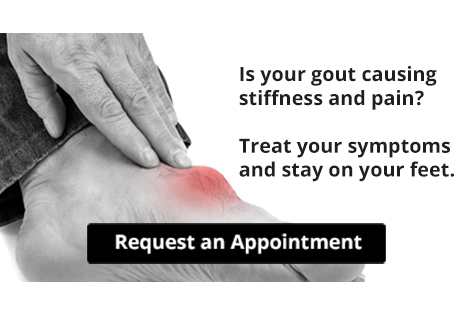Connect With Us
Blog
Items filtered by date: July 2025
Gout Pain Can Be Managed
Early Care of Foot Ulcers Is Vital

A foot ulcer is an open sore that can affect the surface skin or extend deep enough to reach tendons, bones, or other structures. People with diabetes, poor circulation, nerve damage, or foot deformities face a higher risk of developing ulcers. Nerve damage can make it hard to notice injuries like cuts or pressure spots, especially when wearing shoes that rub against the skin. Poor circulation slows healing by limiting the oxygen that reaches tissues in the foot. If left untreated, a foot ulcer may become infected, sometimes leading to an abscess, cellulitis, or a bone infection. In severe cases, it can cause tissue death or result in limb loss. Early care by a podiatrist focuses on diagnosing the cause of the ulcer, removing dead tissue, if needed, and helping to prevent infection. If you have developed a foot ulcer that will not heal, it is suggested that you schedule an appointment with a podiatrist for an exam and appropriate treatment options.
Wound care is an important part in dealing with diabetes. If you have diabetes and a foot wound or would like more information about wound care for diabetics, consult with one of our podiatrists from Whitestone Podiatry PC. Our doctors will assess your condition and provide you with quality foot and ankle treatment.
What Is Wound Care?
Wound care is the practice of taking proper care of a wound. This can range from the smallest to the largest of wounds. While everyone can benefit from proper wound care, it is much more important for diabetics. Diabetics often suffer from poor blood circulation which causes wounds to heal much slower than they would in a non-diabetic.
What Is the Importance of Wound Care?
While it may not seem apparent with small ulcers on the foot, for diabetics, any size ulcer can become infected. Diabetics often also suffer from neuropathy, or nerve loss. This means they might not even feel when they have an ulcer on their foot. If the wound becomes severely infected, amputation may be necessary. Therefore, it is of the upmost importance to properly care for any and all foot wounds.
How to Care for Wounds
The best way to care for foot wounds is to prevent them. For diabetics, this means daily inspections of the feet for any signs of abnormalities or ulcers. It is also recommended to see a podiatrist several times a year for a foot inspection. If you do have an ulcer, run the wound under water to clear dirt from the wound; then apply antibiotic ointment to the wound and cover with a bandage. Bandages should be changed daily and keeping pressure off the wound is smart. It is advised to see a podiatrist, who can keep an eye on it.
If you have any questions please contact our office located in Whitestone, NY . We offer the newest diagnostic and treatment technologies for all your foot and ankle needs.
Nerve Pain From Tarsal Tunnel Syndrome
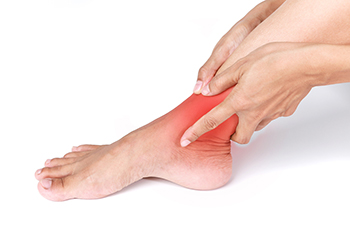
Tarsal tunnel syndrome is a nerve compression condition affecting the foot and ankle, similar to carpal tunnel syndrome in the wrist. It occurs when the posterior tibial nerve is compressed as it passes through the tarsal tunnel, a narrow space located behind the inner ankle bone and covered by a thick ligament. This pressure may be caused by flat feet, swelling, trauma, varicose veins, or space-occupying growths, such as ganglion cysts. As the nerve becomes irritated, patients often experience tingling, burning pain, numbness, or electric shock sensations along the inside of the ankle or the bottom of the foot. A podiatrist can assess nerve function with physical tests and imaging, and may recommend nerve studies to confirm the diagnosis of tarsal tunnel syndrome. In cases where symptoms persist, surgery may be needed to relieve the pressure on the nerve. If you are experiencing numbing in the inner ankle and foot, it is suggested that you make an appointment with a podiatrist for a diagnosis and treatment.
Ankle pain can have many different causes and the pain may potentially be serious. If you have ankle pain, consult with one of our podiatrists from Whitestone Podiatry PC. Our doctors will assess your condition and provide you with quality foot and ankle treatment.
Ankle pain is any condition that causes pain in the ankle. Due to the fact that the ankle consists of tendons, muscles, bones, and ligaments, ankle pain can come from a number of different conditions.
Causes
The most common causes of ankle pain include:
- Types of arthritis (rheumatoid, osteoarthritis, and gout)
- Ankle sprains
- Broken ankles
- Achilles tendinitis
- Achilles tendon rupture
- Stress fractures
- Tarsal tunnel syndrome
- Plantar fasciitis
Symptoms
Symptoms of ankle injury vary based upon the condition. Pain may include general pain and discomfort, swelling, aching, redness, bruising, burning or stabbing sensations, and/or loss of sensation.
Diagnosis
Due to the wide variety of potential causes of ankle pain, podiatrists will utilize a number of different methods to properly diagnose ankle pain. This can include asking for personal and family medical histories and of any recent injuries. Further diagnosis may include sensation tests, a physical examination, and potentially x-rays or other imaging tests.
Treatment
Just as the range of causes varies widely, so do treatments. Some more common treatments are rest, ice packs, keeping pressure off the foot, orthotics and braces, medication for inflammation and pain, and surgery.
If you have any questions please feel free to contact our office located in Whitestone, NY . We offer the newest diagnostic tools and technology to treat your foot and ankle needs.
What You Need to Know About Achilles Tendon Injuries
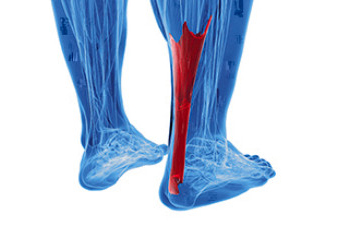
Achilles tendon injuries involve damage to the strong band of tissue connecting the calf muscles to the heel bone. These injuries can range from inflammation to partial or complete tears. Common causes include overuse, sudden increases in activity, tight calf muscles, or improper footwear. Symptoms include heel pain, stiffness, swelling, or a snapping sensation during movement. Risk factors include intense physical activity, poor conditioning, and certain medical conditions. A podiatrist can diagnose the injury through examination and imaging, then recommend treatments such as rest, stretching, or orthotics. If you are experiencing pain in the back of the heel, it is suggested that you visit a podiatrist for an accurate diagnosis and effective treatment.
Achilles tendon injuries need immediate attention to avoid future complications. If you have any concerns, contact one of our podiatrists of Whitestone Podiatry PC. Our doctors can provide the care you need to keep you pain-free and on your feet.
What Is the Achilles Tendon?
The Achilles tendon is a tendon that connects the lower leg muscles and calf to the heel of the foot. It is the strongest tendon in the human body and is essential for making movement possible. Because this tendon is such an integral part of the body, any injuries to it can create immense difficulties and should immediately be presented to a doctor.
What Are the Symptoms of an Achilles Tendon Injury?
There are various types of injuries that can affect the Achilles tendon. The two most common injuries are Achilles tendinitis and ruptures of the tendon.
Achilles Tendinitis Symptoms
- Inflammation
- Dull to severe pain
- Increased blood flow to the tendon
- Thickening of the tendon
Rupture Symptoms
- Extreme pain and swelling in the foot
- Total immobility
Treatment and Prevention
Achilles tendon injuries are diagnosed by a thorough physical evaluation, which can include an MRI. Treatment involves rest, physical therapy, and in some cases, surgery. However, various preventative measures can be taken to avoid these injuries, such as:
- Thorough stretching of the tendon before and after exercise
- Strengthening exercises like calf raises, squats, leg curls, leg extensions, leg raises, lunges, and leg presses
If you have any questions please feel free to contact our office located in Whitestone, NY . We offer the newest diagnostic tools and technology to treat your foot and ankle needs.
The Impact of High Heels on Foot Health
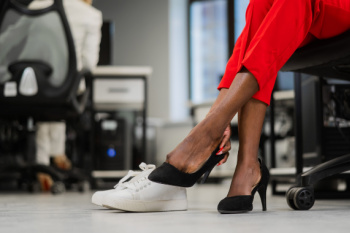
Wearing high heels regularly can significantly affect foot structure and movement. Heels alter natural gait, forcing the body to lean forward and placing excess pressure on the ball of the foot. This unnatural position can lead to pain, calluses, and long-term joint stress. High heels also create ankle instability, increasing the risk of sprains or fractures from sudden twists or missteps. Over time, frequent use may lead to chronic foot discomfort and toe deformities. A podiatrist can evaluate foot health, provide relief strategies, and recommend supportive footwear alternatives. If you experience foot pain from wearing heels, it is suggested that you seek guidance from a podiatrist to restore comfort, improve balance, and protect your feet from further damage or injury.
High heels have a history of causing foot and ankle problems. If you have any concerns about your feet or ankles, contact one of our podiatrists from Whitestone Podiatry PC. Our doctors can provide the care you need to keep you pain-free and on your feet.
Effects of High Heels on the Feet
High heels are popular shoes among women because of their many styles and societal appeal. Despite this, high heels can still cause many health problems if worn too frequently.
Which Parts of My Body Will Be Affected by High Heels?
- Ankle Joints
- Achilles Tendon – May shorten and stiffen with prolonged wear
- Balls of the Feet
- Knees – Heels cause the knees to bend constantly, creating stress on them
- Back – They decrease the spine’s ability to absorb shock, which may lead to back pain. The vertebrae of the lower back may compress.
What Kinds of Foot Problems Can Develop from Wearing High Heels?
- Corns
- Calluses
- Hammertoe
- Bunions
- Morton’s Neuroma
- Plantar Fasciitis
How Can I Still Wear High Heels and Maintain Foot Health?
If you want to wear high heeled shoes, make sure that you are not wearing them every day, as this will help prevent long term physical problems. Try wearing thicker heels as opposed to stilettos to distribute weight more evenly across the feet. Always make sure you are wearing the proper shoes for the right occasion, such as sneakers for exercising. If you walk to work, try carrying your heels with you and changing into them once you arrive at work. Adding inserts to your heels can help cushion your feet and absorb shock. Full foot inserts or metatarsal pads are available.
If you have any questions, please feel free to contact our office located in Whitestone, NY . We offer the newest diagnostic and treatment technologies for all your foot care needs.
Causes of Falls in Seniors
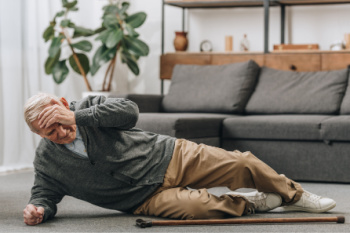
Millions of Americans aged 65 and older visit the emergency department each year after a fall, and problems with feet and ankles are often key contributors. Issues such as weakened foot muscles, stiff toes, limited ankle range, numbness, or pain reduce balance and raise the risk of stumbling. A podiatrist can evaluate foot alignment, joint mobility and nerve function, then recommend supportive footwear, custom orthotic inserts or shoe modifications to increase stability. They can also design exercise programs to improve foot strength and ankle flexibility, as well as test the soles of your shoes and fit to ensure safe traction. Early identification of issues like bunions or sensory loss allows a podiatrist to intervene before balance is compromised. Focusing on foot and ankle health, such as improving toe grip, ankle motion and proper shoe choice, helps lower the risk of falls. If you are a senior who has fallen or is at risk of doing so, it is suggested that you schedule an appointment with a podiatrist for preventative guidance or treatment.
Preventing falls among the elderly is very important. If you are older and have fallen or fear that you are prone to falling, consult with one of our podiatrists from Whitestone Podiatry PC. Our doctors will assess your condition and provide you with quality advice and care.
Every 11 seconds, an elderly American is being treated in an emergency room for a fall related injury. Falls are the leading cause of head and hip injuries for those 65 and older. Due to decreases in strength, balance, senses, and lack of awareness, elderly persons are very susceptible to falling. Thankfully, there are a number of things older persons can do to prevent falls.
How to Prevent Falls
Some effective methods that older persons can do to prevent falls include:
- Enrolling in strength and balance exercise program to increase balance and strength
- Periodically having your sight and hearing checked
- Discuss any medications you have with a doctor to see if it increases the risk of falling
- Clearing the house of falling hazards and installing devices like grab bars and railings
- Utilizing a walker or cane
- Wearing shoes that provide good support and cushioning
- Talking to family members about falling and increasing awareness
Falling can be a traumatic and embarrassing experience for elderly persons; this can make them less willing to leave the house, and less willing to talk to someone about their fears of falling. Doing such things, however, will increase the likelihood of tripping or losing one’s balance. Knowing the causes of falling and how to prevent them is the best way to mitigate the risk of serious injury.
If you have any questions, please feel free to contact our office located in Whitestone, NY . We offer the newest diagnostic and treatment technologies for all your foot care needs.
